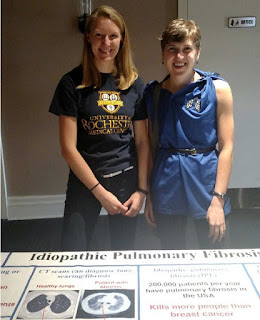Thursday, October 13, 2016
Throwback Thursday: 2011 Biomedical Humanities Reflection
As an undergraduate at Hiram College, I minored in Biomedical Humanities. This interdisciplinary academic area involved scientific courses, service work, and medical humanities (the study of the intersection of medicine and humanities, such as philosophy, religion, literature, and the arts). For the Minor, I had to write a reflective essay on my experiences that helped me determine what I wanted to do after graduation, as well as present the piece to my peers. Now, I am currently in a similar situation to my senior year at Hiram, since I am hoping to defend my thesis in the upcoming spring. At this time in my life, I am often thinking about the future. However, on this #Throwback_Thursday, I decided to look back over my reflection on wanting to study Toxicology. Check it out at https://drive.google.com/file/d/0B9jdg-QyDgxHREFJVlR5cTQyczQ/view?usp=sharing. Reading back over this essay, which described my undergraduate enthusiasm for scientific research, study abroad experience in Guatemala, observations from shadowing healthcare workers, course work (ranging from Organic Chemistry to Humanities) that inspired me, and more, is reinvigorating. I can feel the energy and excitement from my younger self, and it makes me want to work hard to accomplish my goal of getting a PhD.
Wednesday, October 12, 2016
Portrait of Pulmonary Fibrosis
I just wanted to post the "Portrait of Pulmonary Fibrosis" piece that I shared with the Pulmonary Fibrosis Foundation (PFF):
I'm Claire McCarthy from Rochester, NY and I'm 27 years old. As a PhD Student in Toxicology at the University of Rochester, a PFF Care Center Network site, I have become friends with individuals living with idiopathic pulmonary fibrosis (IPF) and their family members.
Q from PFF: What would surprise us to learn about you?
A: Before I joined the laboratory of Dr. Patricia Sime who is on the Pulmonary Fibrosis Foundation Medical Advisory Board for my graduate studies, I had never heard of pulmonary fibrosis.
At lab meetings and working with my colleagues, I learned about the biology of lung scarring and the statistics of survival (showing that many people only live 3-5 years after diagnosis). This helped me realize the importance of scientific research for pulmonary fibrosis; however, meeting people living with the disease and their family members is what really allowed me to understand the impact that pulmonary fibrosis has on so many people.
For example, I’ll never forget the conversation that I had with a patient with idiopathic pulmonary fibrosis (IPF) who had a lung transplant. I asked him, “What does pulmonary fibrosis feel like?”
I was educated about the pathology of lung fibrosis in the lab, but had never really heard about the experience of a person with IPF. He told me he was never in pain, but he would walk up three steps and have to stop. He couldn’t catch his breath or get enough oxygen. He described how his disease progressed fairly quickly, like the low level of water that rapidly spirals down around the drain of a sink.
Then he discussed his recovery after his lung transplant. He said that when the intubation tube was taken out, his first inhale of air was like a baby’s first breath. He also discussed that when he was diagnosed with IPF, he went to church and asked God to help him deal with the illness. After that, he was never afraid.
Listening to the stories of other PF patients and their family members affected by pulmonary fibrosis changed my perspective.
Now I think about more than just the science of the disease, and remember the importance of interactions between researchers, clinicians, and families.
We all need to work together to both help people with pulmonary fibrosis in multiple aspects of their well-being and develop effective therapies for this illness.
Subscribe to:
Comments (Atom)
